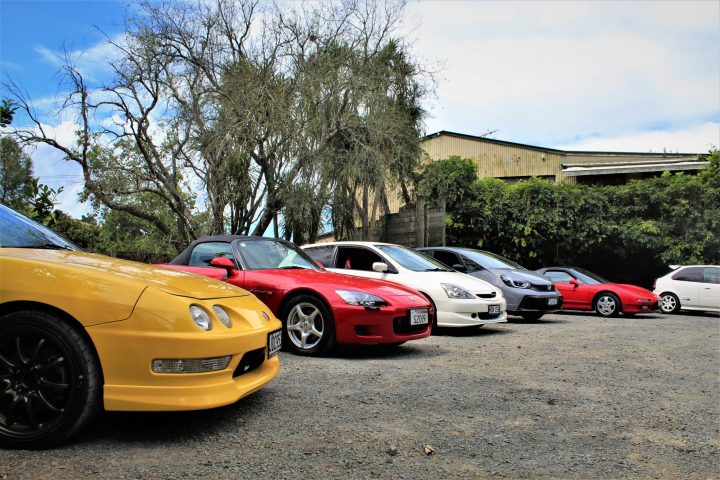
The full Honda review
It’s always good fun when Honda New Zealand launch a new car. However, when Honda NZ got in touch this time around and said they would be launching the new-look Jazz hatchback at Kauri Bay Boomrock just outside Auckland, a few special treats were in store for all who chose to attend.
Not only would it give fellow automotive scribes and I the chance to experience the new Honda Jazz in a picturesque setting on great roads, but also a chance to play with cars from Honda’s heritage collection.
The heritage collection has been handpicked by the team at Honda New Zealand and contains vehicular archive of some of their most coveted models from throughout the history of Honda. The line up consisted of a gaggle of Type R Hondas, an S2000 and the mighty NSX supercar from the early nineties.
So, without further ado, here are my initial thoughts on the new Honda Jazz, and just some of Honda New Zealand’s Heritage Collection.
Honda Civic Type R EK9
First up was a car I have been wantin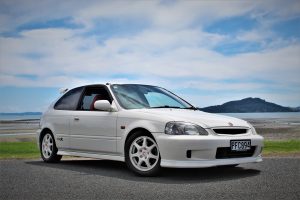 g to drive for years, the EK9 Civic Type R. The first Civic to wear the Type R emblem, the EK9 was based on the Honda Civic EK4 SIR hatchback but both inside and out was heavily modified to reflect its sporting pretentions.
g to drive for years, the EK9 Civic Type R. The first Civic to wear the Type R emblem, the EK9 was based on the Honda Civic EK4 SIR hatchback but both inside and out was heavily modified to reflect its sporting pretentions.
Under the bonnet sits a 1.6L naturally aspirated four-cylinder engine. It may not sound like much from the outset, but don’t forget Honda’s legendary VTEC variable valve timing and lift electronic control system. Trying not to get two technical here, VTEC allows to different camshaft profiles, meaning at low rpm, the EK9’s 136kW B16B engine can be tailored for economy and easy city driving. However, build up the revs and beyond 6,000 to the screaming 8,000rpm redline, the cam profile changes and the EK9 becomes a blisteringly fast pocket rocket.
Keen to test this out after years of waiting, I soon found myself snuggly seated in the EK9 Type R’s red Recaro bucket seats. The driving position is perfect and the gear lever for the five-speed manual transmission is close and easy to get at. The ergonomics are tailor made for keen drivers.
Heading off towards Kawakawa Bay, the EK9 got into its stride nicely. It’s a loud car but its by no means deafening. However, venture beyond 6,000rpm, the cam profile changes and all your surroundings are engulfed by a cacophony of VTEC induced four-cylinder bliss. It’s a raspy mechanical ballad and one which you can instantly identify as a classic Honda.
On the handling front, the EK9 is pin sharp and exciting, very much like a go-kart. It seems to know where you are going before you do. This telepathic communication between car and driver, coupled with that aforementioned VTEC scream, the EK9 really did live up to expectations. No, scratch that. It surpassed them. It’s a hard charging, well balanced performance car which can churn out thrills by the minute if you push it hard enough.
Built from 1998 to 2000, the EK9 Civic Type R has well and truly joined the dream garage list.
Honda Integra Type R DC2 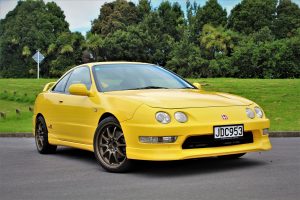
Next up was the Type R Honda which preceded the EK9, the DC2 Integra Type R. Launched in 1995, the DC2 Integra Type R carried on the Type R lineage laid down by the original NSX Type R of 1992. Honda New Zealand’s collection wouldn’t be complete without a DC2 Integra as it brough the Type R mantra to a greater section of the buying public, first in Japan, and then in the US and UK.
Under the bonnet sat a highly tuned version of Honda’s B18C VTEC engine with 147kW mated to a five-speed manual transmission. Drive went to the front wheels and a helical limited slip-differential gave the Type R a significant boost of performance over the Integra SIR-G which sat below it in the range. The Type R was also lighter inside and out resulting in a zero to 100km/h time of 6.1 seconds, not bad today but pretty quick for the time.
I remember a time when DC2 Integra Type Rs were a dime a dozen. Today things couldn’t be more different, which is why examples like this low mileage bright yellow DC2 are getting pretty hard to find.
Much like the EK9, the DC2 serves up a purposeful cabin, though there are decidedly more buttons and switches in the Integra over the Civic. Ahead of you sit the classic white on black dials with that 8500rpm glaring at you. You sit snuggly and low down and a quick turn of the key ignites the B18C with a pronounced mechanical burble.
Like the EK9, the DC2 is lively as heck when you put your foot down. In some ways it feels tighter and more solid than the Civic but no less a thrilling drive. Sauntering down to Clevedon town and back for half an hour was a more than adequate time to get that VTEC singing and to devour some bendy bitumen. The DC2 goes hard like the EK9 and when you keep it between 6000 and 8000rpm, is just as fun whether on the straights or the corners. A classic? Darn right.
Honda Jazz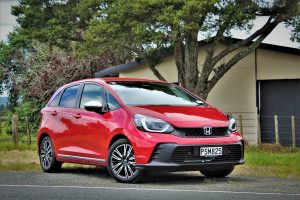
As we approached the mid-point of the day, it was time experience the main reason for travelling to Kauri Bay, the new look Honda Jazz.
Honda claim the new Jazz has been developed with Honda’s racing spirit in mind, encompassing technologies which carry on the ethos of Honda’s motorsport side. As company founder Soichirro Honda said, “If Honda does not race, there is no Honda.”
The new Jazz consists of three spec levels, the Jazz Crosstar at $30,700, the Jazz RS at $36,700 and the flagship Jazz Luxe Sport at $37,000. All prices are exclusive of on road costs. Both the
So, what of this theme of “Sport Genetics” for the new Jazz? Well, its easy to see this sporting influence in how the new Jazz looks. Yes it is largely a facelift but the addition of a new “Aggressive Sport” design which includes a new sports grill, front bumper and rear spoiler. This are not just cosmetic either, these additives are fully functional while in turn greatly increasing aerodynamic flow.
The new Jazz has a tweaked version of the tried and test e:HEV hybrid system. The 1.5L four cylinder petrol engine has seen a 7kW increase in power to 78kW and the electric drive motor and generator motor now produces 90kW and 78kW respectively. The set up also serves up a sharper throttle response and more power available lower down. The RS gets revised sporty suspension and underpinnings and new deacceleration paddles to provide four levels of deacceleration to suit each drive.
While I wasn’t able to sample the new RS, I was fortunate enough to spend a brief amount of time with the range topping Jazz Luxe Sport. Here Honda have made easily the most luxurious Jazz yet. The fact my car came with the optional tan quilted leather seats just added to this premium feel.
Move off and you can see how these little tweaks to the new Jazz have made a considerable difference in the way it drives. It feels more eager than before and in the corners it does hold a more precise line and feels less wayward. It’s a good mix of open road comfort with a sportier feel. There is also a new drive mode switch which allows you to choose from three different drive modes, normal, sport and econ.
Honda plans to sell over 2000 Jazz in 2023 and if this first impression is anything to go by, it will come as no surprise if they do just that.
Right, back to the Honda’s of yesteryear.
Honda Civic Type R EP3
The Civic EP3 Type R was a step away from what we had become used to when it was launched in 2001. Based on the seventh generation Civic, it was built at Honda’s UK plant in Swindon and were sold predominately in the European market. Power was rated at 147kW from its K20A VTEC four-cylinder engine and it still retained all the Type R madness from the EK9 including those red Recaro Bucket Seats.
The EP3 was a Civic Type R I was also anxious to try. Not only because for a long time they were a rare sight on Kiwi roads, but this UK built hot hatch has been raved about at length by the UK motoring press for years. Time to find out if such ravings are to be believed.
In short, they are. The EP3 was a big surprise for I believe it as eager and as quick as the EK9. The six-speed manual box is also a delight to use and being mounted on the centre console, means every change is a short sharp throw which doesn’t require taking your hand off the wheel for long.
Combine that VTEC power and work that gear box to your advantage and the EP3 is very much a hard charger. Its relatively compact dimensions make it a more chuckable car than the EK9. With that intense throttle response thrown in, it isn’t long before you are attacking each corner with a certain degree of verve. Also, it is said if you push hard enough you will get one rear wheel off the ground, though I didn’t do this.
The EP3 Civic Type R is a ball of laughs, though to get the most out of it, you have to wring its neck a lot of the time. That aside, when you consider the rising value of some of its other Type R contemporaries, the EP3, with its red bucket seats and screaming K20C engine is, for now at least, great value for money.
Honda S2000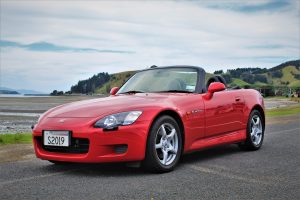
Then it was time to go topless. The Honda S2000 is hands-down one of the greatest sports cars of the modern era. With a screaming 2.0L F20C VTEC engine producing 184kW and 218Nm of torque, it will happily rev out in typical Honda fashion to 9000rpm. Production lasted from 1999 to 2009 with the AP1, featured here and later AP2 variants today holding their value immensely due to its cult following and continuing strong demand from enthusiasts and collectors.
This AP1 is one of a handful of New Zealand New S2000s. You can tell this by the registration number. Jump in and you are greeted by yet another driver focused cabin. There are no distractions or flashy buttons to take your mind off the task of driving. In fact, the only thing which does light up is the digital instrument cluster, especially that lightbar rev counter.
Leaving the car park at Kauri Bay Boom Rock, I though the S2000 would be ideally suited for that same run to Kawakawa Bay and perhaps a bit beyond. It is incredibly well behaved a cruising speed and while you get the buffeting you would expect from a car with its roof down, its actually quite civilised.
Right, time to get into it. The K20C VTEC four pot is incredible. Every fibre of my being was saying “change up” when we got close to 7000rpm, but that extra 2000rpm was still there waiting to be used. Revving out to that 9000rpm leaves that aforementioned instrument cluster flashing brightly, then you dive for the next gear and the process begins all over again.
The six-speed manual transmission is like a bolt action rifle, the rear drive handling is superb and it feels as tight as the day it left the factory. It’s easy to see why the S2000 is already a classic. It’s just epic.
Honda NSX
The Honda NSX. Developed by Formula One legend, Ayrton Senna, the NSX was able to go toe-to-toe with the Ferrari 348 of the day and beat it at its own game. Sadly, due to overwhelming demand from my fellow motoring scribes and the fact that I had to fly back to Christchurch meant there was not time available for a sprint in Honda’s supercar.
In Conclusion
While Honda did provide the option for attendees to play a bit of golf and other non-car related recreational activities, it is pretty fair to say, no-one took them up on this. We were just all agog for their fleet of analogue high powered toys from yesteryear. Needless to say, Honda New Zealand will have to work pretty hard to top this drive day in terms of smiles per hour.



